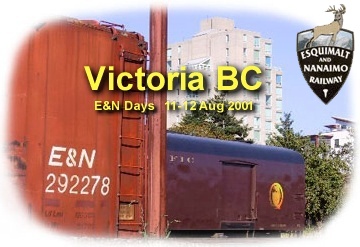|
CPR Historical Display
Cars

E&N Days
Canadian Pacific Railway Historical
Display Cars number 80 and 81 arrived at the Esquimalt roundhouse Thursday, 9
August 2001. The arrival was in anticipation of E&N Days on Saturday and
Sunday, 11-12 August 2001. This celebration commemorates the driving of the
Esquimalt & Nanaimo Railway's last spike on 13 August 1886, by Sir John A.
MacDonald, first Prime Minister of Canada. An announcement by the Town Crier
officially opening the two day event was followed by the cutting of a birthday
cake. The general public examined the two display cars, rode in Fairmont speeders,
( One complete with a very loud air horn. ) and pumped themselves up and down the
yard track on a handcar and a three wheeled velocipede. The history of the display
cars follow, courtesy of the CPR:
Display Cars 80 and 81
Two cars in Canadian Pacific Railway's fleet stand apart from the rest. CPR's
display cars - CP 80 and CP 81.
Delivered as horse express cars
These smooth-sided steel cars, measuring nearly 84 feet ( 25.6 meters ), look very
much like baggage cars. But Canadian Car and Foundry of Montreal originally built
these two cars for CPR as horse express cars. Designed in 1947 but not delivered
until early 1949, CPR first put them into service on the Company's western lines in
February 1949. The two horse express cars differ from most baggage cars with three
sets of side-doors instead of two. These cars also have a large
end-door for loading and unloading circus-ramp-style.
The two cars, delivered as CP 4560 and CP 4565, were each equipped to accommodate
18 horses and six attendants. Touted by enthusiastic horsemen as riding "as
smoothly as a passenger car", they originally carried valuable race horses and
thoroughbred saddle horses.
Palletized-freight cars
In 1964 the cars were refitted to carry palletized cargo and small containers, and
used between Montreal and Saint John, New Brunswick. As a result they were
renumbered CP 4600 and CP 4601.
Baggage cars
A few years later the cars were converted for through-baggage-car
service and eventually renumbered CP 2600 and CP 2601.
Display cars
In 1974 the cars were taken out of regular service and assigned to the CPR's Public
Relations and Advertising department ( currently Government and Public Affairs ) as
display cars. They were renumbered CP 80 and CP 81.
As display cars, CP 80 and CP 81 have shown off everything from a
32-foot ( 9.75 meter ) N-scale model railway layout, to a
17-foot ( 1.85 meter ), 2,000 Lb. ( 907 Kg. ), One-sixth
actual size, CPR Royal Hudson locomotive. They also once housed a comprehensive
display on CPR's $500 million Rogers Pass Project.
The cars are now each equipped with a diesel generator that powers their video
monitors, play-back units, fans, track lighting, and illuminates their
onboard back-lit transparencies.
CPR's logos
The cars were revamped for the historic Fall 1997 "Logotrain" tour
launching CPR's new beaver logo.
As visitors board CP 80 they are first given a taste of CPR's history, with a
railway artifacts display, an historic photo-wall, and enlarged
bygone-era posters. The back end of the car features CPR's logos
through the years, complemented by the video "Beaver Tracks" tracing logo
changes throughout the Company's history. CP 81 shows us commodities important to
the country and CPR, as well as pictures of CPR's Calgary head-office
and the Network Management Center. Visitors then pass through a safety display
including Operation Lifesaver video commercials. The "piece de resistance"
as visitors exit the car is an actual General Electric AC4400CW console from CPR's
new 4,400 horsepower, AC-traction locomotives.
These two cars were recently the second and third cars in the consist pulled by
Hudson locomotive 2816, the Empress, from Vancouver to Calgary during the steam
engines inaugural run after rebuilding.
Vital Statistics
|
Car Numbers:
|
CP 4560 / 4600 / 2600 / 80
CP 4565 / 4601 / 2601 / 81
|
|
No. in Class:
|
2
|
|
AAR type:
|
M510
|
|
Builder:
|
Canadian Car and Foundry
|
|
Enter Service:
|
February 1949
|
|
No. of Trucks:
|
2
|
|
No. of Axles:
|
4
|
|
Light Weight:
|
122,900 Lbs.
55,747 Kg.
|
|
Extreme Length:
|
83 ft. 11 in.
25.58 meters
|
|
Extreme Height:
|
13 ft. 9 in.
4.19 meters
|
|
Extreme Width:
|
10 ft. 7 in.
3.23 meters
|
|
Original Cost per Car:
|
$64,658.
|
Associated Links
Canadian Pacific Railway
© Copyright 2002 William C.
Slim
pacificcoast.net/~slim
|